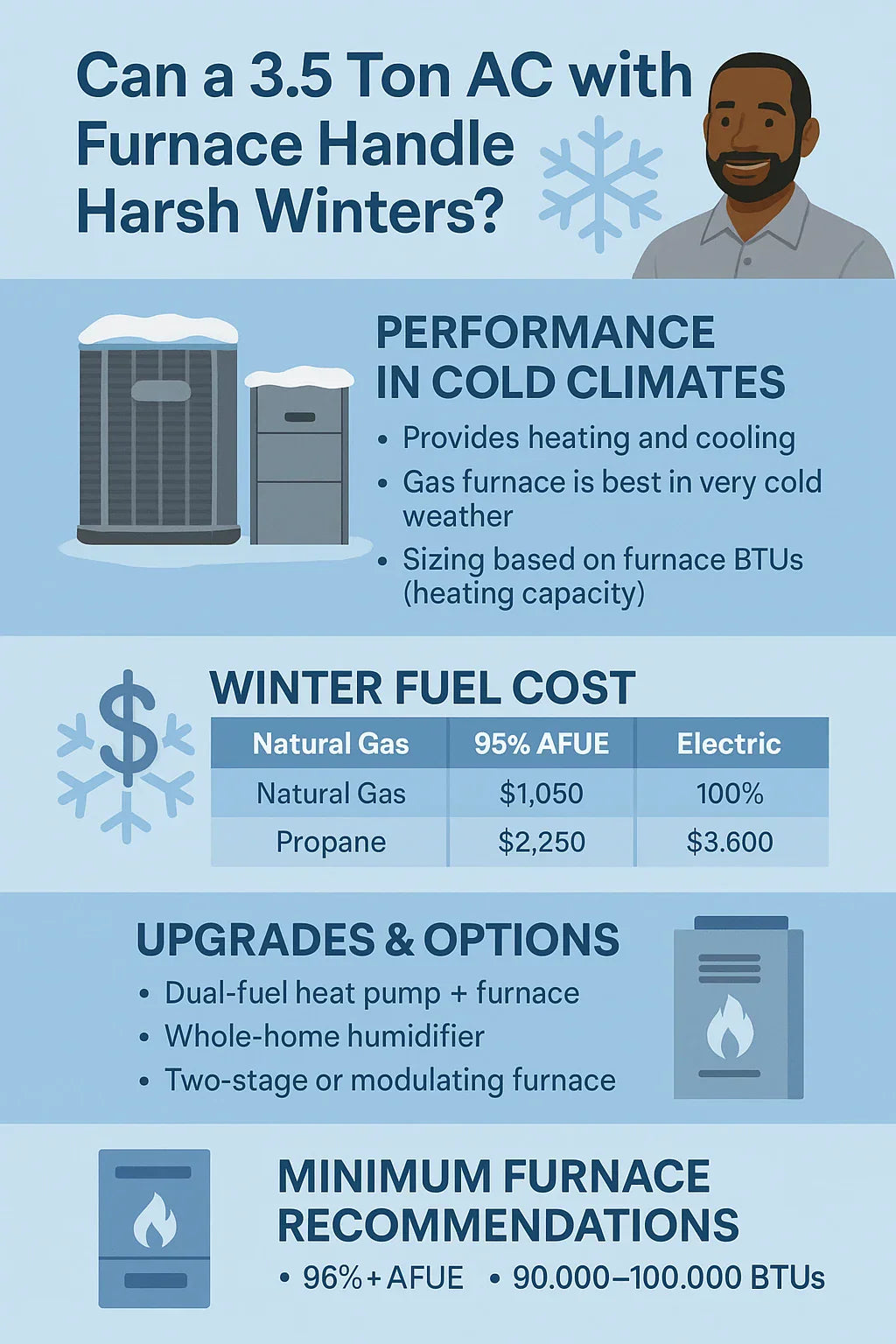📘 Introduction: Heating Reliability in Harsh Winters
When winter temperatures regularly drop below 0°F (-18°C), a reliable heating system isn’t a luxury — it’s survival gear. For homeowners with long, icy winters in places like Minnesota, Maine, or the Canadian border states, the question becomes:
“Can a 3.5 ton AC with furnace keep my home warm without skyrocketing my heating bills?”
The short answer? Yes — if you choose the right furnace, size it properly, and maintain it well. But there’s more to it than simply ordering a 3.5 ton unit.
🌡 How a 3.5 Ton AC with Furnace Works Year-Round
A 3.5 ton AC with furnace system is a split system that cools in summer and heats in winter.
-
Summer: The outdoor condenser and indoor evaporator coil remove heat from your home.
-
Winter: The furnace takes over, either burning fuel (gas, propane, oil) or using electric resistance to heat the air.
Key point: The 3.5 ton rating applies to the cooling capacity, not heating. Furnace heating capacity is measured in BTUs (British Thermal Units).
🔥 Gas vs. Electric Furnace in Cold Climates
In cold climates, gas furnaces are usually the preferred choice.
| Feature | Gas Furnace | Electric Furnace |
|---|---|---|
| Efficiency | 80–98% AFUE | 95–100% efficient |
| Operating Cost | Lower in most cold regions | Much higher in cold climates |
| Heating Speed | Very fast | Slower, steady |
| Fuel Availability | Requires natural gas or propane | Requires high electric capacity |
📎 Reference: Energy Star – Furnace Types
Why gas wins in cold climates:
-
Lower cost per BTU compared to electric resistance heat.
-
Higher heat output, keeping up with demand in subzero weather.
📏 Sizing & BTU Requirements for Cold Weather
For a 2,000–2,400 sq. ft. well-insulated home in a cold climate:
-
Furnace output: 80,000–100,000 BTU/hr
-
AFUE rating: 95% or higher recommended
Manual J load calculation ensures:
-
Proper heating output for your specific home
-
Avoiding oversizing (which causes short cycling and uneven heating)
📎 Reference: ACCA Manual J Load Calculation
❄ Performance Challenges in Harsh Winters
-
Heat Loss in Older Homes
-
Poor insulation, drafty windows, and unsealed ductwork can waste 20–30% of heat.
-
-
Consistent Comfort
-
Two-stage or modulating furnaces maintain steady indoor temps better than single-stage units.
-
-
Humidity Issues
-
Cold air holds less moisture — dry air can cause discomfort, static shocks, and wood damage.
-
-
Fuel Supply Concerns
-
In rural areas, propane delivery delays can be a risk in heavy snow.
-
💲 Cost to Operate in Winter
Example: 2,200 sq. ft. home in Minneapolis, MN — 5 months heating season.
| Fuel Type | Furnace Efficiency | Seasonal Fuel Cost (2025 prices) |
|---|---|---|
| Natural Gas | 95% AFUE | ~$1,050 |
| Propane | 95% AFUE | ~$2,250 |
| Electric | 100% | ~$3,600 |
📎 Reference: EIA Energy Price Data
🛠 Upgrade & Backup Options
-
Dual-Fuel Systems
-
Pair a high-efficiency heat pump with a gas furnace.
-
Heat pump handles milder winter days; furnace kicks in when temps drop below 35°F.
-
-
Whole-Home Humidifiers
-
Keeps indoor RH at 35–45%, preventing dryness.
-
-
Smart Thermostats with Outdoor Sensors
-
Automatically switch between heat pump and furnace for best efficiency.
-
📌 Mark’s Recommendations for Cold Climates
-
AFUE Rating: Aim for 96–98% for gas; avoid electric unless electricity is very cheap in your area.
-
BTU Output: For most homes in harsh winters, 90,000–100,000 BTU.
-
Staging: Choose at least two-stage or modulating for steady heat and better efficiency.
-
Backup Heat: Have a secondary heating option in case of fuel shortages or outages.
📎 Verified External References
✅ Conclusion
A 3.5 ton AC with a properly sized, high-efficiency furnace can absolutely handle harsh winters — but only if you:
-
Match furnace BTU output to your heating load
-
Choose high-efficiency equipment
-
Address insulation and air sealing
-
Plan for backup heat in emergencies
Think of it as a partnership between the furnace and the home — the tighter and better insulated your home, the easier it is for your furnace to keep you cozy no matter what the thermometer says.
In the next topic we will read more about: Troubleshooting Guide: Common 3.5 Ton AC and Furnace Issues and How to Fix Them







